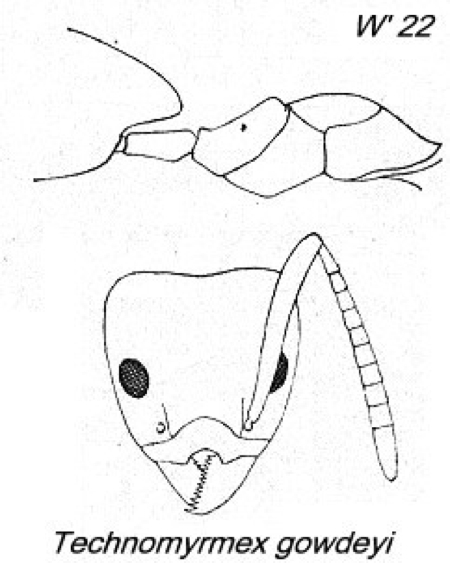Technomyrmex (Engramma) ilgi (Forel)
  Type location Ethiopia
(Engramma ilgi n. sp., Forel, 1910c: 264, worker & male)
collected
by Laurent - see below Type location Ethiopia
(Engramma ilgi n. sp., Forel, 1910c: 264, worker & male)
collected
by Laurent - see below
junior synonyms
stygius (Engramma stygium n. sp.,
Santschi, 1911c: 363, worker & male; Santschi, 1914b, 117, queen)
from Kenya, Nairobi, Ch. Alluaud, 1904 - see below
gowdeyi (Engramma
gowdeyi, Wheeler, 1922: 207, illustrated, worker) from Uganda,
Kampala, collector C.C. Gowdey - no images on Antweb (April 2015)
synonymies by Bolton (2007: 22)  . .
|

Technomyrmex (Engramma) gowdeyi (Wheeler)
Type location Uganda (not Zaïre; Engramma
gowdeyi new species, Wheeler, 1922: 207, Fig. 53, worker,
illustrated), combination in Technomyrmex
by Shattuck (1992b); all forms described (Bolton, 1995, where type
location was wrong).
Wheeler (1922, with the illustration) wrote - The
following species, though not from the Congo, may be most conveniently
described in this place.
WORKER - Length 2.4 to 2.7 mm. Head without the
mandibles distinctly longer than broad, broader behind than in front,
with feebly concave posterior border and feebly convex sides. Eyes
flat, in front of the middle of the head, about one-fifth as long as
its sides. Mandibles convex, with about a dozen even, crowded teeth.
Clypeal notch about one-fourth the length of the anterior border,
broader than deep, with sharp, slightly produced corners. Posterior
clypeal border distinct; frontal area and groove obsolete; frontal
carinae nearer to the sides of the head than to each other. Antennal
scapes extending about one-sixth their length beyond the occipital
border; funicular joints 2 to 10 perceptibly longer than broad. Thorax
short, seen from above with distinctly angular humeri; promesonotal and
metanotal sutures distinct; pro- and mesonotum moderately convex, the
latter broadly elliptical, slightly broader than long; metanotal
constriction rather deep, acute. Propodeum as long as broad, broader
behind than in front, in profile with a short base, rising rather
steeply from the metanotal groove, one-fourth as long as the flat,
backwardly sloping declivity. Petiole elliptical, flat, its node
obsolete. Gaster rather voluminous, its first segment overlying the
petiole; anus terminal. Legs rather slender. Shining; very finely and
uniformly punctate.
Hairs sparse, blackish, erect, rather coarse, present on the clypeus,
vertex, pronotum, mesonotum, and propodeum, and all the segments of the
gaster. Pubescence grayish, short and fine, rather abundant, covering
the whole body but not concealing the shining surface. Castaneous
brown; thorax and anterior portion, of head paler; mandibles,
insertions of antennae, funiculi, tarsi, and articulations of legs
yellowish brown.
Described from numerous specimens taken by Mr. C. C.
Gowdey at Kampala, Uganda. I at, first supposed this form to be E.
ilgi subspecies stygium Santschi, described from British
East Africa, but careful perusal of the description shows that it is
quite distinct.
|